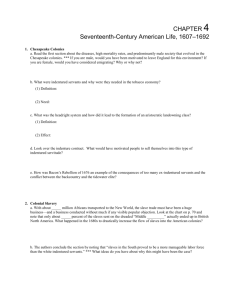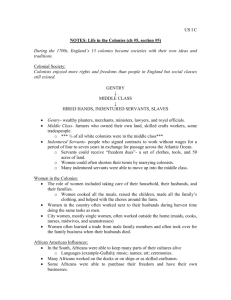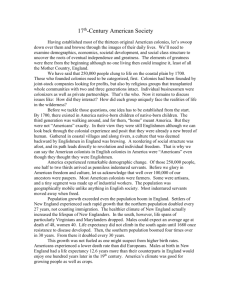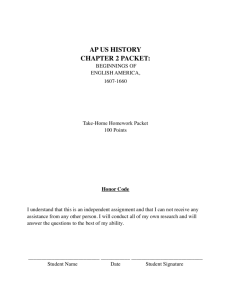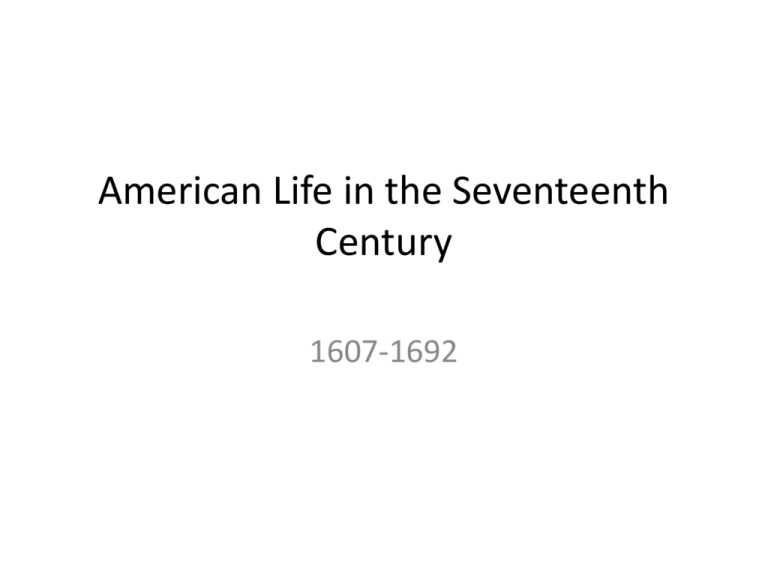
American Life in the Seventeenth
Century
1607-1692
Key Concept 2.1: Europeans developed a variety of colonization and migration
patterns, influenced by different imperial goals, cultures, and the varied
North American environments where they settled, and they competed with
each other and American Indians for resources.
I. Spanish, French, Dutch, and British colonizers had different economic and
imperial goals involving land and labor that shaped the social and political
development of their colonies as well as their relationships with native
populations.
A) Spanish efforts to extract wealth from the land led them to
develop institutions based on subjugating native populations, converting
them to Christianity,
and incorporating them, along with enslaved and free Africans, into the
Spanish colonial society.
B) French and Dutch colonial efforts involved relatively few
Europeans and relied on trade alliances and intermarriage with American
Indians to build economic and diplomatic relationships and acquire furs and
other products for export to Europe.
C) English colonization efforts attracted a comparatively large
number of male and female British migrants, as well as other European
migrants, all of whom sought social mobility, economic prosperity, religious
freedom, and improved living conditions. These colonists focused on
agriculture and settled on land taken from Native Americans, from whom
they lived separately.
•
•
•
•
•
•
II. In the 17th century, early British colonies developed along the Atlantic coast,
with regional differences that reflected various environmental, economic, cultural,
and demographic factors.
A) The Chesapeake and North Carolina colonies grew prosperous exporting
tobacco — a labor-intensive product initially cultivated by white, mostly male
indentured servants and later by enslaved Africans.
B) The New England colonies, initially settled by Puritans, developed around
small towns with family farms and achieved a thriving mixed economy of
agriculture and commerce.
C) The middle colonies supported a flourishing export economy based on
cereal crops and attracted a broad range of European migrants, leading to societies
with greater cultural, ethnic, and religious diversity and tolerance.
D) The colonies of the southernmost Atlantic coast and the British West
Indies used long growing seasons to develop plantation economies based on
exporting staple crops. They depended on the labor of enslaved Africans, who
often constituted the majority of the population in these areas and developed
their own forms of cultural and religious autonomy.
E) Distance and Britain’s initially lax attention led to the colonies creating
self-governing institutions that were unusually democratic for the era. The New
England colonies based power in participatory town meetings, which in turn
elected members to their colonial legislatures; in the Southern colonies, elite
planters exercised local authority and also dominated the elected assemblies.
•
•
•
•
•
•
•
III. Competition over resources between European rivals and American Indians
encouraged industry and trade and led to conflict in the Americas.
A) An Atlantic economy developed in which goods, as well as enslaved
Africans and American Indians, were exchanged between Europe, Africa, and the
Americas through extensive trade networks. European colonial economies focused
on acquiring, producing, and exporting commodities that were valued in Europe
and gaining new sources of labor.
B) Continuing trade with Europeans increased the flow of goods in and out
of American Indian communities, stimulating cultural and economic changes and
spreading epidemic diseases that caused radical demographic shifts.
C) Interactions between European rivals and American Indian populations
fostered both accommodation and conflict. French, Dutch, British, and Spanish
colonies allied with and armed American Indian groups, who frequently sought
alliances with Europeans against other Indian groups.
D) The goals and interests of European leaders and colonists at times
diverged, leading to a growing mistrust on both sides of the Atlantic. Colonists,
especially in British North America, expressed dissatisfaction over issues including
territorial settlements, frontier defense, self-rule, and trade.
E) British conflicts with American Indians over land, resources, and political
boundaries led to military confrontations, such as Metacom’s War (King Philip’s
War) in New England.
F) American Indian resistance to Spanish colonizing efforts in North America,
particularly after the Pueblo Revolt, led to Spanish accommodation of some
aspects of American Indian culture in the Southwest.
Key Concept 2.2: The British colonies participated in political, social,
cultural, and economic exchanges with Great Britain that encouraged
both stronger bonds with Britain and resistance to Britain’s control.
•
•
•
•
•
I. Transatlantic commercial, religious, philosophical, and political exchanges led
residents of the British colonies to evolve in their political and cultural attitudes as
they became increasingly tied to Britain and one another.
A) The presence of different European religious and ethnic groups
contributed to a significant degree of pluralism and intellectual exchange, which
were later enhanced by the first Great Awakening and the spread of European
Enlightenment ideas.
B) The British colonies experienced a gradual Anglicization over time,
developing autonomous political communities based on English models with
influence from intercolonial commercial ties, the emergence of a trans-Atlantic
print culture, and the spread of Protestant evangelicalism.
C) The British government increasingly attempted to incorporate its North
American colonies into a coherent, hierarchical, and imperial structure in order to
pursue mercantilist economic aims, but conflicts with colonists and American
Indians led to erratic enforcement of imperial policies.
D) Colonists’ resistance to imperial control drew on local experiences of selfgovernment, evolving ideas of liberty, the political thought of the Enlightenment,
greater religious independence and diversity, and an ideology critical of perceived
corruption in the imperial system.
II. Like other European empires in the Americas that participated in the
Atlantic slave trade, the English colonies developed a system of slavery
that reflected the specific economic, demographic, and geographic
characteristics of those colonies.
A) All the British colonies participated to varying degrees in the
Atlantic slave trade due to the abundance of land and a growing
European demand for colonial goods, as well as a shortage of
indentured servants. Small New England farms used relatively few
enslaved laborers, all port cities held significant minorities of enslaved
people, and the emerging plantation systems of the Chesapeake and
the southernmost Atlantic coast had large numbers of enslaved
workers, while the great majority of enslaved Africans were sent to the
West Indies.
B) As chattel slavery became the dominant labor system in many
southern colonies, new laws created a strict racial system that
prohibited interracial relationships and defined the descendants of
African American mothers as black and enslaved in perpetuity.
C) Africans developed both overt and covert means to resist the
dehumanizing aspects of slavery and maintain their family and gender
systems, culture, and religion.
• Theme: In the Chesapeake region,
seventeenth-century colonial society was
characterized by disease-shortened lives,
weak family life, and a social hierarchy that
included hardworking planters at the top and
restless poor whites and enslaved Africans at
the bottom
• Despite the substantial disruption of their
traditional culture and the mingling of African
peoples, slaves in the Chesapeake developed a
culture that mixed African and new-world
elements, and developed one of the few slave
societies that grew through natural
reproduction.
• Theme: By contrast, early New England life
was characterized by healthy, extended life
spans, strong family life, closely knit towns
and churches, and a demanding economic and
moral environment.
The Chesapeake
-Life was “nasty, brutish, and short”
-Disease was prevalent
-Majority of immigrants were young single men
-Families were fragile and few
-Weak family ties
-Tobacco economy
The “headright” system
• Virginia and Maryland
• Whoever paid the passage of a laborer
received the right to acquire fifty acres of
land.
• The tobacco economy first thrived on the
labor of white indentured servants, who
hoped to work their way up to become
landowners and perhaps even become
wealthy. But by the late seventeenth century,
this hope was increasingly frustrated and the
discontents of the poor whites exploded in
Bacon’s Rebellion.
Bacon’s Rebellion
• Governor Berkeley faced Bacon’s Rebellion
(1676) led by Nathaniel Bacon.
• Because of Berkeley’s friendly policies toward
Indians, he refused to retaliate against a series of
brutal Indian attacks.
• Bacon and his frontier followers took matters into
their own hands.
• After Bacon died from disease, Berkeley brutally
suppressed the rebellion.
• Afterwards, planters sought a less troublesome
source of labor for tobacco.
Southern Society
• Wide gaps in social structure developed
– Planters at the top of the social pyramid
(controlled the economy and monopolized
political power)
• (powerful planter families included the Fitzhughs, the
Lees, and the Washingtons.)
– Small farmers (the largest social group)
– Landless whites (many former indentured
servants)
– Indentured servants
– Slaves
• Few cities developed
• Waterways provided the principal means of
transportation
• Fragility of families contributed to women’s
property rights and economic security
Indentured Servitude
• 100,000 brought to the region by 1700
• Three-quarters of all European immigrants to
Virginia and Maryland in the 17th century.
• Land grants were not given to freed indentured
servants as land grew more scarce
• Conditions grew more harsh
• By 1680s, with the English economy improving,
less people were willing to leave England to
become indentured servants in America
Slavery
• With white labor increasingly troublesome,
slaves (earlier a small fraction of the
workforce) began to be imported from West
Africa by the tens of thousands in the 1680s
and soon became essential to the colonial
economy.
• 10 million Africans were brought to the New
World
• 400,000 brought to North America, the majority
after 1700
• By 1680s black slaves outnumbered white
servants among the immigrants coming to the
plantations
• 1750- slaves accounted for about half the
population in Virginia
• In South Carolina, blacks outnumbered whites
two to one
• 1.5 million pounds of tobacco shipped by 1630s.
40 million pounds by end of century.
• 1662 in Virginia the law began to make
distinctions between slaves and servants largely
on the basis of race
• Slave codes- made slaves and their children
property (chattel)
• “Slaves might have begun in America for
economic reasons, but by the end of the
seventeenth century, it was clear that racial
discrimination also powerfully molded the
American slave system.” (Pageant)
The Deep South
• Slave life was even more severe
• Widely scattered rice and indigo plantations
• Slaves in the Deep South died rapidly of
disease and overwork, but those in the
Chesapeake tobacco region survived longer.
Their numbers eventually increased by natural
reproduction and they developed a distinctive
African American way of life that combined
African elements with features developed in
the New World.
Map 4-1 p65
p65
p66
African American Culture
Various African cultures and dialects melded
into a new African American culture
Contributions
-words such as gumbo and voodoo
-the ringshout contributed to the
development of jazz
-the banjo and the bongo drum
p69
Slave Uprisings
• 1712- New York City
• 1739- Stono River, South Carolina- fifty slaves
tried to march to Spanish Florida
– http://nationalhumanitiescenter.org/pds/becomin
gamer/peoples/text4/stonorebellion.pdf
p70
New England
• By contrast with the South, New England’s
clean water and cool air contributed to a
healthy way of life, which added ten years to
the average English life span.
• The New England way of life centered on
strong families and tightly knit towns and
churches, which were relatively democratic
and equal by seventeenth-century standards.
•
•
•
•
Tended to migrate as families
Population grew from natural reproduction
Stable families
Women had fewer property rights than in the
South
• Puritanism made for unity of purpose and
concern for the moral health of the whole
community
• Towns were required to provide elementary
education
• Most adults knew how to read and write
• Democracy in Congregational Church
government led to greater democracy in
political government
• Less ethnically mixed than southern colonies
• Soil and climate encouraged diversified
agriculture
• Slavery was not profitable on small farms
• Relatively egalitarian society
John Winthrop
• One of the founders and governor of the
Massachusetts Bay Colony
• There is a twofold liberty, natural . . . and civil or
federal. The first is common to man with beasts and
other creatures. By this, man, as he stands in relation
to man simply, hath liberty to do what he lists; it is a
liberty to evil as well as to good. This liberty is
incompatible and inconsistent with authority and
cannot endure the least restraint of the most just
authority. The exercise and maintaining of this liberty
makes men grow more evil and in time to be worse
than brute beasts . . . . This is that great enemy of
truth and peace, that wild beast, which all of the
ordinances of God are bent against, to restrain and
subdue it.
• The other kind of liberty I call civil or federal; it
may also be termed moral, in reference to the
covenant between God and man, in the moral
law, and the politic covenants and constitutions
amongst men themselves. This liberty is the
proper end and object of authority and cannot
subsist without it; and it is a liberty to that only
which is good, just, and honest. This liberty you
are to stand for, with the hazard (not only of your
goods, but) of your lives, if need be. Whatsoever
crosseth this is not authority but a distemper
thereof.
• This liberty is maintained and exercised in a
way of subjection to authority; it is of the
same kind of liberty wherewith Christ hath
made us free. The women's own choice makes
such a man her husband; yet, being so chosen,
he is her lord, and she is to be subject to him,
yet in a way of liberty, not of bondage; and a
true wife accounts her subjection her honor
and freedom and would not think her
condition safe and free but in her subjection
to her husband's authority.
• By the late seventeenth century, however,
social and religious tensions developed in
these narrow communities, as the Salem
witch hysteria dramatically illustrates.
• Puritan belief remained, but religious zeal was
weakening
– Half-Way Covenant- unconverted children of
members could be baptized but not admitted to
full communion
• Weakened distinction between elect and others
• Doors of Puritan churches eventually opened
to all comers, whether converted or not.
• Strict religious purity was sacrificed to the
cause of wider religious participation.
• Women became the majority of churchgoers.
Salem Witch Trials
• 1692- Twenty accused witches were killed
• Most of the accused came from families
associated with Salem’s growing market
economy; the accusers from subsistence
farming families
• Widening social stratification was one cause
• Other causes?
Map: The Geography of Witchcraft: Salem Village, 1692
The Geography of Witchcraft: Salem Village, 1692
Geographic patterns of witchcraft testimony mirrored tensions within Salem Village. Accused witches and their defenders
lived mostly in the village's eastern division or in Salem town, whereas their accusers overwhelmingly resided in the village's
western sector.
Copyright © Houghton Mifflin Company. All rights reserved.
p74
• Rocky soil forced many New Englanders to
turn to fishing and merchant shipping for their
livelihoods. Their difficult lives and stern
Calvinist religion made New Englanders tough,
idealistic, purposeful, and resourceful. In later
years they spread these same values across
much of American society.
The Middle Colonies
• Less social rigidity than in New England and
the Chesapeake
• Generally religiously tolerant
• Mixture of agriculture and light manufacturing
Some generalizations of 17th century
colonial society
• Seventeenth-century American society was still almost
entirely simple and agrarian. Would-be aristocrats who
tried to recreate the social hierarchies of Europe were
generally frustrated.
• Land was relatively cheap
• Compared to most Europeans, Americans lived in
abundance
• Most white migrants came from the social level
between the aristocracy and the bottom of society
• Fragrant displays of class distinction were not really
possible
• 1689–1691: Leisler’s Rebellion in New York
was caused by animosity between lordly
landholders and aspiring merchants.
• Efforts to reproduce the finely stratified
societies of Europe proved feeble in early
America, where equality and democracy
found fertile soil—at least for white people.

